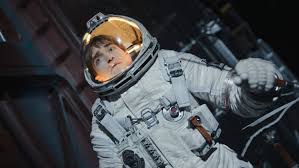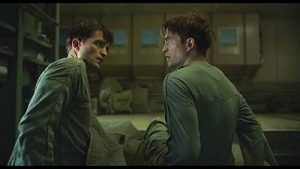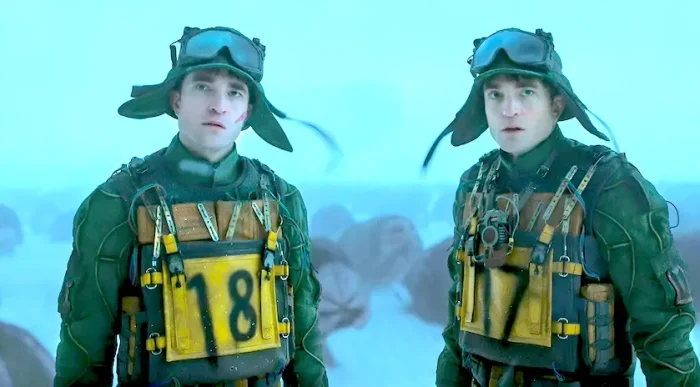Reviewed by Jeffrey Sanzel
“Have a nice death. See you tomorrow.” This single line captures the plot, theme, and tone of Mickey 17, writer-director Bong Joon Ho’s follow-up to his award-winning film Parasite.
Edward Ashton’s novel Mickey7 was among NPR’s Best Sci-Fi Books of 2022 and was nominated for Best Science Fiction Book by Goodreads. Now, Bong Joon Ho brings the novel to the big screen in an epic adaptation titled Mickey 17. The first-rate cast features Robert Pattinson, Naomi Ackie, Steven Yeun, Toni Collette, and Mark Ruffalo.

In the year 2054, sad sack Mickey Barnes (Pattinson) and his friend, the opportunist Timo (Yeun), are pursued by a vicious loan shark. The pair decide to escape Earth, signing up for a four-and-a-half-year voyage to Niflheim, a planet colonizing under the rule of the failed multi-millionaire politician Kenneth Marshall (Ruffalo). The unskilled Timo finagles a position as a shuttle pilot. Conversely, the doubt-plagued Mickey signs on as an “Expendable.”
Using a cloning technique banned on Earth, Mickey is subjected to experiments and fatal assignments to make the new planet habitable. After he dies, he is literally reprinted, including uploading his memories and personality traits. (The visual printing is one of the film’s most memorable visuals.) Along the way, Mickey develops a relationship with Nasha Barridge (Ackie), a strong-willed, free-spirited security agent.
The complications come when Timo erroneously reports Mickey 17’s death, unaware that the planet’s indigenous lifeforms, Creepers, rescued Mickey 17. Unknowingly, the scientists generate Mickey 18, the brashest and most aggressive Mickey. This mistake generates the forbidden “Multiples” situation. The dual Mickeys introduce an element of farce into this hybrid of dark comedy, science fiction, horror, and satire.
Robert Pattinson departs from his usual leading man persona for Mickey 17. The fatally passive titular clone is the definition of the little man lost in society, almost blithely accepting his fate. He is a man who signed away his life without reading the contract. Mickey 18 is closer to Pattinson’s usual undertakings, the curled, lipped, sexually charged bad boy. Pattinson adeptly creates two visually identical but wholly contrasting characters.

At the center of the film is the buffoonish but appallingly dangerous leader, the egomaniacal and photo-op-obsessed Marshall. Easily manipulated by his underlings and his diabolical wife (Collette), Ruffalo embodies the danger and idiocy of an oligarchical politician with too much power and money and very little brain power. The performance is a hilarious horror, as the fascist clown spews white supremacist hate speech aimed specifically at Niflheim’s resident Creepers. Collette matches Ruffalo, all blazing eyes and sharpened talons, whispering in his ear like a demented Lady MacB.
The entire cast is effective, alternating the comedic with the callous. Ackie exudes a rough charm as the daring and audacious Barridge. Yeun brings an off-handed charm to the morally bankrupt Timo. Even Patsy Ferran, as scientist Dorothy, creates dimension in one of the few caring team members.
Cinematographer Darius Khondji and production designer Fiona Crombie perfectly complement each other, capturing the overdeveloped Earth, the dark, cramped spaceship and colony quarters, and the bleak tundra of Niflheim. Bong and his frequent collaborator, Jang Hee-chul, designed the Creepers, which are simultaneously adorable and repellent.
Bong makes clear commentary with Marshall’s pejorative orations on a white master race, the eradication of the native Creepers, and acceptable scientific experimentation on people who are “expendable.” The presence of Marshall’s followers in their red baseball caps is a pointed statement; depending on one’s leanings, this is either the film’s strength or flaw. Mickey 17’s lack of subtlety often pushes the film from social satire into spoof.
Like with Parasite, Bong proves he is a master of bold cinematic strokes and unusual and exceptional focus. However, unlike its Academy Award-winning predecessor, Mickey 17 has excess in both grotesquerie and running time. If Bong did not surpass his masterpiece, Mickey 17 offers a bleak, often brutally funny, and ultimately engaging film.
Rated R, the film is now playing in local theaters.





